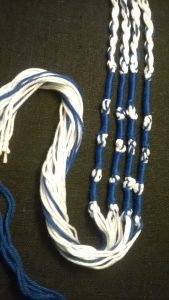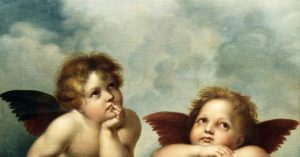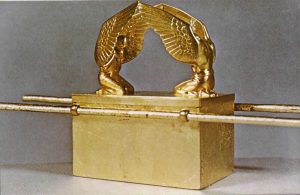Teruma 2020: Jews, Synagogues, and FaceTime
by devadmin | February 26, 2020 2:20 pm
Jews, Synagogues, and FaceTime
Jewish people, especially those who go to shul daily, or at least on shabbis, must know -within a few feet- just where the nearest shul is located. When considering a new neighborhood, shul attending Jews drive to a desired shul, set their odometers to zero, and begin driving up to one mile in every direction. And while planning a vacation or considering a vacation home, a Jew must know how just how far the shul is from his hotel, rental, or the apartment one is considering as a second or vacation home. The shul is ground zero. Moreover, Jews -practicing and not- love spotting shuls wherever in the world they find themselves. They don’t necessarily want to go in to daven but are thrilled when spotting one. Why? Ver veyst? Jews get excited and marvel at shuls built in unexpected places. It’s in our DNA. The first ever shul of sorts, the first ever sanctuary, appears in this week’s parsha; it’s in Teruma where the RBSO orders Moishe to build Him a house of sorts, a Mishkan, a sanctuary. We shall be discussing that below, ober let’s quickly look back.
 Two parshas back the Yiddin married the RBSO and were the recipients of the Aseres Hadibrois (Ten Commandments). Later in that same parsha, meaning not too much time later, they violated at least one when they killed Chur. Last week in Mishpotim, the RBSO revealed over 50 new commandments – mitzvos in every variety but mostly dealing with civil and tort laws. The RBSO of course already knew there was no shot the Yiddin would be able to obey these; perhaps He gave us a total of 613 hoping that His Chosen People would observe at least a few. A nechtiger tug (not a shot); His people have not disappointed. The RBSO also knew the Yiddin would build an eygel and commit myriad other sins; He does know all! And He also knew that one day soon, Miraglim (scouts) would be sent to reconnoiter the Promised Land and that they would come back speaking loshoin horo about the Land. As an aside, less than a handful of people the Oisvorfer has met in his lifetime, don’t speak any. And by less than a handful what is mean is zero. As a result, He would declare the Yiddin not ready from prime time, not ready to enter the Land. And taka that’s what happened resulting in a 40- year sentence of sojourning the midbar, moving to and from various encampments and midways just to pass the time.
Two parshas back the Yiddin married the RBSO and were the recipients of the Aseres Hadibrois (Ten Commandments). Later in that same parsha, meaning not too much time later, they violated at least one when they killed Chur. Last week in Mishpotim, the RBSO revealed over 50 new commandments – mitzvos in every variety but mostly dealing with civil and tort laws. The RBSO of course already knew there was no shot the Yiddin would be able to obey these; perhaps He gave us a total of 613 hoping that His Chosen People would observe at least a few. A nechtiger tug (not a shot); His people have not disappointed. The RBSO also knew the Yiddin would build an eygel and commit myriad other sins; He does know all! And He also knew that one day soon, Miraglim (scouts) would be sent to reconnoiter the Promised Land and that they would come back speaking loshoin horo about the Land. As an aside, less than a handful of people the Oisvorfer has met in his lifetime, don’t speak any. And by less than a handful what is mean is zero. As a result, He would declare the Yiddin not ready from prime time, not ready to enter the Land. And taka that’s what happened resulting in a 40- year sentence of sojourning the midbar, moving to and from various encampments and midways just to pass the time.
And this week? Knowing all this in advance and to keep them busy and engaged, the RBSO embarks on a major construction project, the building of a tabernacle and sanctuary; let’s call it the Mishkan project. The Mishkan project takes us all the way through the end of Shmois. Of course, every religious project requires architecture, engineering -some also zoning- materials, donations and other monies. As an aside, there is a machloikes (dispute) as to whether or not the RBSO ordered the Mishkan built before or after the sin of the golden calf, ober for this review which follows the order of the parshas, we will assume that Mishkan was ordered pre-eygel sin. We will not be reading of the golden-calf caper for another two shabosim.
 Welcome then to Parshas Teruma where the project is introduced, zoning is seemingly as of right (who was going to complain, the neighbors?), and where the RBSO will delineate a very specific materials list needed to build the exterior, and design the interiors of the various structures He had in mind. It was His House! In prior postings on this parsha we described the procurement of the various materials and we wondered just where the Yiddin were to find these items? We knew they left Mitzrayim with gold, silver and clothing. We knew that additional riches were spit up by the sea when the Mitzrim drowned. Ober how in the world and where, were they to get their hands on certain items such as ticheyles, the tachash skins, and certain semi-precious stones? And the answer? Ver veyst? Were there pop up shops in the desolate midbar? Was there a body of water nearby where the chilozoin fish happened to be swimming in? There was not; hence the Yiddin were constantly complaining about the lack of water. The answer to all these questions is azoy: unlike reality TV shows such as The Amazing Race or other treasure hunts where the items to be located are all placed and hidden in advance, and all the participants need to do is find them, here in the midbar all they could rely on was midbar magic. And a magical place it was. Taka our sages who grappled with these same issues were forced to declare that certain items appeared by miracle. Is that so far-fetched? Avada not! That particular generation of Yiddin -as we have been saying over and again- were already accustomed to seeing and witnessing miracles. Need ticheyles which in the ordinary course was made only from the chilozin fish and which –according to some- appears but once every 70 years? No problem for the RBSO. Need a certain tachash skin which is made from yet another animal not seen before and has never again been seen? No problem for the RBSO. And just like that, all the times on the RBSO’s materials list were sourced and delivered to Moishe.
Welcome then to Parshas Teruma where the project is introduced, zoning is seemingly as of right (who was going to complain, the neighbors?), and where the RBSO will delineate a very specific materials list needed to build the exterior, and design the interiors of the various structures He had in mind. It was His House! In prior postings on this parsha we described the procurement of the various materials and we wondered just where the Yiddin were to find these items? We knew they left Mitzrayim with gold, silver and clothing. We knew that additional riches were spit up by the sea when the Mitzrim drowned. Ober how in the world and where, were they to get their hands on certain items such as ticheyles, the tachash skins, and certain semi-precious stones? And the answer? Ver veyst? Were there pop up shops in the desolate midbar? Was there a body of water nearby where the chilozoin fish happened to be swimming in? There was not; hence the Yiddin were constantly complaining about the lack of water. The answer to all these questions is azoy: unlike reality TV shows such as The Amazing Race or other treasure hunts where the items to be located are all placed and hidden in advance, and all the participants need to do is find them, here in the midbar all they could rely on was midbar magic. And a magical place it was. Taka our sages who grappled with these same issues were forced to declare that certain items appeared by miracle. Is that so far-fetched? Avada not! That particular generation of Yiddin -as we have been saying over and again- were already accustomed to seeing and witnessing miracles. Need ticheyles which in the ordinary course was made only from the chilozin fish and which –according to some- appears but once every 70 years? No problem for the RBSO. Need a certain tachash skin which is made from yet another animal not seen before and has never again been seen? No problem for the RBSO. And just like that, all the times on the RBSO’s materials list were sourced and delivered to Moishe.
Ober this week, in year ten of the Oisvorfer’s most amazing parsha reviews, we shall focus in on the kiruvim (cherubim). The what? What are they? How were they designed? What were they used for? And the questions are just beginning. Where, if anyplace before this week’s parsha have we encountered keruvim? Let’s begin by reading a few pisukim. Says the heylige Toirah (Shmois 25:17-22) azoy:
“And you shall make an ark-cover [kapoires] of pure gold: two cubits and a half shall be the length thereof, and a cubit and a half the breadth thereof. And you shall make two keruvim of gold; of beaten work shall you make them, at the two ends of the ark-cover. And make one keruv at the one end, and one keruv at the other end; of one piece with the ark-cover shall you make the keruvim of the two ends thereof. And the keruvim shall spread out their wings on high, screening the ark-cover with their wings, with their faces one to another; toward the ark-cover shall the faces of the keruvim be. And you shall put the ark-cover above upon the ark; and in the ark you shall put the testimony that I shall give you. And there I will meet with you, and I will speak with you from above the ark-cover, from between the two keruvim which are upon the ark of the testimony, of all things which I will give you in commandment to the children of Israel.”
Six pisukim (verses) and seven mentions of a “keruv” or “keruvim” but not once does the heylige Toirah tell us what these keruvim are. What to do? Not to worry because avada if the RBSO gave instructions for them to be embroidered, sewn, carved or built, someone needed to know how, what, when, and where. Let us begin.
Says Wikipedia: A cherub or cherubim –keruv and keruvim in English- is/are one of the unearthly beings who directly attend to the RBSO. Numerous depictions of cherubim assign to them many different roles, such as protecting the entrance of Gan Eden (Garden of Eden). They did what? They guarded the entrance? Where did we read that? We will address that mamish below ober you should know that in the Book of Yichezkel (Ezekiel), he the great visionary and prophet, and in other works by our Christian friends, the cherub is depicted as having two pairs of wings, and four faces: that of a lion, an ox, a human, and an eagle. In other words: various people see the keruvim (cherubs) as having faces of either a lion, ox, eagle and even human; no one cherub had all four faces. Their legs were straight, the soles of their feet like the hooves of a bull, gleaming like polished brass. Some early midroshim conceive of them as non-corporeal. Veyter. So happens that when we imagine a cherub, the image we conjure up is that of a pudgy angelic looking baby with wings. Why? Ver veyst? And taka if you Google cherub and look for images, you will find just that. Ober, what’s that image based on? And the answer? As it turns out, Google’s source may be the heylige Gemora (what else is there) and other medroshim, perhaps even Rashi in our parsha.
And now that you read the pisukim, here are a few more questions: Why did the RBSO want keruvim (Cherubim) in the Mishkan (sanctuary) and why were they to be placed at the “two ends of the ark cover?” What did they mean and represent? What was the importance of their facing one another? Any by facing each other, were they the forerunners of FaceTime invented by an Apple engineer in 2010? Was there in fact significance to them facing one another? We shall explore these questions below.
From the text we know this about the keruvim in our parsha: there were two of them, we know their position on the curtain covering the ark, and that they were to be fashioned out of gold. Ober what we don’t know is this, what is cherub? What does it actually look like? Who knew? As stated above, our parsha describes the building of the utensils of the Mishkan and central to the Mishkan, was the Oroin koidesh (the Ark), which contained the two luchois. The ark was to be covered by the kapoires which was to be adorned with two keruvim. Ober what were these keruvim? We are not told. And here the fun begins. Most people have seen drawings of a nicely trimmed golden box with poles at the sides and two angelic figures on top, wings often joined at the tips. But what were the keruvim really? Why did they raise more concern and critique among the commentators than any other utensil, and what symbolic meaning do they convey?
Shoin: if the heylige Toirah left us thinking, avada we can count on the heylige Gemora to fill in this lacuna and which in Chagigga 13a tells us azoy: What is a Keruv? Reb Avahu said: Ke-ravia, since in Babylon, a child is called ravia. Rebbe Pupa said to Abaya: It is stated, “The first was the face of a cherub, and the second was the face of a man, and the third the face of a lion…” – is not the face of a cherub the face of a man?! Says Rashi quoting the heylige Gemora (Chagiga 13b) that they have an infant’s face upon them. Rabaynu Bechaya explains that the word is ke-ruv, and that the “Chof” (“k”) in English) means “like” and “rabia” in some places means a child. Keruvim = like a child. He also suggests that the Keruvim were actually one adult and one child. Others suggest that they are infants- one male and one female. Which was it and what all that means, ver veyst, but Rashi in our parsha (posik 18) suggests azoy: the keruvim had children’s faces. Does everyone agree? Of course not! Say the Rashbam and the Chizkuni, that the keruvim were large winged birds. Done? Not yet because says Rabaynu Bachaya: one of the keruvim may have been in the shape of a man and the other of a small child.
Ober the shaylo is azoy: we have previously met keruvim -though kimat none of you remember. We have? Where? All the way back in Parshas Bereishis. Let’s harken back to the snake, remember him? Of course you do as he was behind man’s original sin. Seemingly he was also in front of Chava, if you chap. The bottom line: the RBSO kicked Odom and Chava out of Gan Eden. He also chopped off the snake’s legs. And then we read this:
Says the heylige Toirah (Bereishis 3:24), azoy. “So He drove out the man; and He placed Keruvim at the east of the garden of Eden, and a flaming sword which turned every way, to guard the way of the tree of life.”
 Noch a mul (one more time): After Odom and Chava were exiled, the RBSO placed keruvim to guard the entrance to block the passage back? Were these real keruvim? Or, were they but images of keruvim as we find elsewhere in our parsha? As an aside keruvim are mentioned three different times in our parsha; on at least one occasion, images of keruvim were to woven or embroidered. Most commentators believe that the keruvim mentioned in connection with guarding Gan Eden, were in fact angels. Says Rashi: the keruvim were angels of destruction. Says the Chizkuni: they were frightening shapes. Says the Rosh: the angles at the entrance to Gan Eden took the form of oxen. Avada these descriptions makes sense if the RBSO meant taka to guard the entrance of Gan Eden; we have to assume that neither Odom or Chava would have been freighted off from entering were they to be encountered by the image of children’s faces, or even friendly angles. And would baby faces be flailing swords in every direction? The bottom line: we don’t know with certainty what the keruvim looked like. As well, we seemingly cannot look to the keruvim in Bereishis and assume these were the same as the keruvim which adorned the poroiches covering the ark which housed the luchois.
Noch a mul (one more time): After Odom and Chava were exiled, the RBSO placed keruvim to guard the entrance to block the passage back? Were these real keruvim? Or, were they but images of keruvim as we find elsewhere in our parsha? As an aside keruvim are mentioned three different times in our parsha; on at least one occasion, images of keruvim were to woven or embroidered. Most commentators believe that the keruvim mentioned in connection with guarding Gan Eden, were in fact angels. Says Rashi: the keruvim were angels of destruction. Says the Chizkuni: they were frightening shapes. Says the Rosh: the angles at the entrance to Gan Eden took the form of oxen. Avada these descriptions makes sense if the RBSO meant taka to guard the entrance of Gan Eden; we have to assume that neither Odom or Chava would have been freighted off from entering were they to be encountered by the image of children’s faces, or even friendly angles. And would baby faces be flailing swords in every direction? The bottom line: we don’t know with certainty what the keruvim looked like. As well, we seemingly cannot look to the keruvim in Bereishis and assume these were the same as the keruvim which adorned the poroiches covering the ark which housed the luchois.
What then were the keruvim in our parsha? Says the Ibn Ezra (in our parsha and in Bereishis), that the word keruv is a term that means form or shape, but it does not refer to a specific shape. According to this pshat, in each case, the Toirah tells us that there is a general form of a keruv guarding the entrance to the garden, and also on the poroiches but does not tell us what that shape is. We assume the RBSO placed frightening looking keruvim to guard the Garden. Exactly what those shapes were, ver veyst? The bottom line: the keruvim were divine messengers wielding swords and perhaps they were malleable; they took on different shapes depending on what the RBSO called for. Now we know! Know what? That we don’t know. Seemingly, those in charge of building them for the Mishkan and later when built again when the Beis Hamikdash was erected, had a vision for them which was pleasing to the RBSO. Veyter.
What we do know with certainty is this: they were to face one another. And we know this because the RBSO specifically so stated. “And the keruvim shall spread out their wings on high, screening the ark-cover with their wings, with their faces one to another; toward the ark-cover shall the faces of the keruvim be.” So far so good but is it? Not! Why not? Because in another verse found in Divrey Hayomim (II Chronicles 3:13) it says, “they faced [the walls of] the room”? Which was it? Did they face each other or the walls? Says the Gemora (Buba Basra 99a) so gishmak azoy: both answers are emes! How could that be? It’s poshit (simple): they faced each other and the wall but at different times. “When the people of Israel fulfilled the RBSO’s will, the cherubim would face each other; and when the people of Israel did not fulfill G-d’s will, the cherubim would face the walls of the room.” Shoin! Avada most husbands and wives can relate; at times when they get along and all is lovey-dovey –not very often- they go to sleep facing each other. Most other times –especially if one has spread their wings epes too far, if you chap, they go to sleep each facing their respective walls. Is the man/woman example so far-fetched? Not! Says this shtikel Gemora (Yoma 54a) azoy: Reb Katina said: Whenever Israel came up [to the Temple] for the festival, the curtain [of the sanctuary] would be removed for them and the keruvim, whose bodies were intertwined, were shown to them. Then [the onlookers] would be thus addressed: Look! You are beloved before Hashem as the love between man and woman!”
We also know this. The keruvim were to be located in the most sacred portion of the Mishkan, the Koidesh Kodoshem (Holy of Holies). And their function? It’s spelled out rather clearly in the pisukim and again in Bamidbar (7:8-9) where we read this: “And when Moishe went into the tent of meeting that He might speak with him, then he heard the voice speaking to him from above the ark-cover that was upon the ark of the testimony, from between the two keruvim; and He spoke to him.” According to this account, the voice was heard from the space between the two keruvim. In other words: when the RBSO spoke to Moishe, the sounds were heard from between the two keruvim. Were the keruvim then a medium of sorts? Were they meant to express what is not there, more than what is? And says the heylige Toirah (Devorim 4:12), azoy: “And the Lord spoke to you out of the midst of the fire; you heard the voice of words, but you saw no form; only a voice.” What all that means, veyst ober we do know that the RBSO has no physical form or shape. So happens that there are many verses spoken by various Prophets describing the RBSO speaking through, sitting on, or being otherwise in proximity to the keruvim.
We find this in the Novee (I Shmuel 4:4): “so the people sent to Shilo, and they brought from thence the ark of the covenant of the Lord of hosts, who sits upon the keruvim; and the two sons of Eli, Chofni and Pinchas, were there with the ark of the covenant of God.
And this in Tihilim (Psalms 80:2-3): “Give ear, O Shepherd of Israel, You that leads Yoisef like a flock; you that sit on the keruvim, shine forth. Before Ephraim and Binyamin stir up Thy might, and come to save us. And this in Tihilim 99:1:The Lord reigns; let the peoples tremble; He sits upon the keruvim; let the earth quake. And this in II Shmuel 6:2: “And David arose and went with all the people that were with him from Ba’alei-Yehuda to bring up from there the ark of God, whereupon is called the Name, even the name of the Lord of hosts that sits upon the keruvim. The bottom line: Many an exegete, and others, offer myriad explanations and attribute many different messages and symbolism to the keruvim. Dozens of pages have been written on the meaning of the Kiruvim; which one is on point? Ver veyst?
And we close with this: why the keruvim were fashioned to face each other when the children of Israel fulfilled the RBSO’s will, ver veyst? One pshat the Oisvorfer came across from Rabbi Yitzchak Elchonon Spector explains that the keruvim were in fact symbolic of the Yiddin. When Jews face each other, that is, when we look at each other with compassion and caring, when we support one another, we are being more than just good citizens; we are performing the will of the Creator in this world. Conversely, when people are shut inside their own walls, when we look only at ourselves and pursue only the fulfillment of our own needs, we are not only ignoring our responsibilities to our fellow man, but we are, in essence, violating the will of the RBSO.
And the final bottom line: many a relationship has gone sour because people could not face each other and talk things out when they should have. FaceTime is a good thing.
A gittin Shabbis-
The Heylige Oisvorfer Ruv
Yitz Grossman
Source URL: https://oisvorfer.com/teruma-2020-jews-synagogues-and-facetime/

